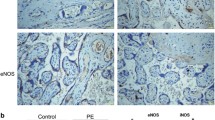Abstract
Purpose
Uterine artery occlusion (UAO) is a promising method for the treatment of leiomyoma. This study is intended to demonstrate the discrepancy of ER stress-induced apoptosis in leiomyoma and myometrium as a result of UAO therapy.
Methods
Primary cultured leiomyoma and myometrial cells were incubated in low oxygen supply (1 % O2). Then, real time RT-PCR and Western blotting were performed to analyze the mRNA and protein levels of ER stress-related molecules including GRP78, CHOP, JNK, Bax, Bcl-2 and Caspase4. Furthermore, the activity of Caspase4 was detected. Tissues of leiomyoma and myometria were also collected before and 30 min after UAO during surgery and evaluated.
Results
The leiomyoma cells and tissues expressed higher ER stress-related molecules compared to myometrial cells or tissues, while the levels of Bcl-2, an anti-apoptotic protein, declined. In myometrial cells, an elevated level of Caspase4 activation as well as its expression was not significant during the first 12 h, suggesting that hypoxia might not intensely affect the myometrium compared with leiomyoma.
Conclusion
ER stress-related apoptosis partly accounts for the effects of UAO therapy on uterine leiomyoma, which leads to the death of leiomyoma while maintaining the survival of the uterus itself.






Similar content being viewed by others
References
Fedele L, Parazzini F, Luchini L, Mezzopane R, Tozzi L, Villa L (1995) Recurrence of fibroids after myomectomy: a transvaginal ultrasonographic study. Hum Reprod 10(7):1795–1796
Liu L, Li Y, Xu H, Chen Y, Zhang G, Liang Z (2011) Laparoscopic transient uterine artery occlusion and myomectomy for symptomatic uterine myoma. Fertil Steril 95(1):254–258
Liu M, Cheng Z, Zhu Y, Dai H, Hu L, Xu L (2011) Prospective comparison of laparoscopic uterine artery occlusion plus myomectomy with classic intrafascial supracervical hysterectomy for symptomatic fibroid treatment: differences in post-operative quality-of-life measures. Eur J Obstet Gynecol Reprod Biol 155(1):79–84
Qu X, Cheng Z, Yang W, Xu L, Dai H, Hu L (2010) Controlled clinical trial assessing the effect of laparoscopic uterine arterial occlusion on ovarian reserve. J Minim Invasive Gynecol 17(1):47–52
Burbank F, Hutchins FL Jr (2000) Uterine artery occlusion by embolization or surgery for the treatment of fibroids: a unifying hypothesis-transient uterine ischemia. J Am Assoc Gynecol Laparosc 7(4 Suppl):S1–S49
Torigian DA, Siegelman ES, Terhune KP, Butts SF, Blasco L, Shlansky-Goldberg RD (2005) MRI of uterine necrosis after uterine artery embolization for treatment of uterine leiomyomata. Am J Roentgenol 184(2):555–559
Cheng Z, Xie Y, Dai H, Hu L, Zhu Y, Gong J (2008) Unequal tissue expression of proteins from the PA/PAI system, myoma necrosis, and uterus survival after uterine artery occlusion. Int J Gynaecol Obstet 102(1):55–59
Cheng ZP, Tao X, Gong J, Dai H, Hu LP, Yang WH (2009) Early-stage morphological observations of myoma and myometrium after laparoscopic uterine artery occlusion treatment. Eur J Obstet Gynecol Reprod Biol 145(1):113–116
Kim I, Xu W, Reed JC (2008) Cell death and endoplasmic reticulum stress: disease relevance and therapeutic opportunities. Nat Rev Drug Discov 7(12):1013–1030
Gorman AM, Healy SJ, Jager R, Samali A (2012) Stress management at the ER: regulators of ER stress-induced apoptosis. Pharmacol Therapeut 134(3):306–316
Wei H, Li Z, Hu S, Chen X, Cong X (2010) Apoptosis of mesenchymal stem cells induced by hydrogen peroxide concerns both endoplasmic reticulum stress and mitochondrial death pathway through regulation of caspases, p38 and JNK. J Cell Biochem 111(4):967–978
Shveiky D, Shushan A, Ben Bassat H, Klein BY, Ben Meir A, Levitzky R et al (2009) Acetaldehyde differentially affects the growth of uterine leiomyomata and myometrial cells in tissue cultures. Fertil Steril 91(2):575–579
Zou CF, Jia L, Jin H, Yao M, Zhao N, Huan J et al (2011) Re-expression of ARHI (DIRAS3) induces autophagy in breast cancer cells and enhances the inhibitory effect of paclitaxel. BMC cancer 11:22
Huang Y, Hua K, Zhou X, Jin H, Chen X, Lu X et al (2008) Activation of the PI3K/AKT pathway mediates FSH-stimulated VEGF expression in ovarian serous cystadenocarcinoma. Cell Res 18(7):780–791
Bae JH, Chong GO, Seong WJ, Hong DG, Lee YS (2011) Benefit of uterine artery ligation in laparoscopic myomectomy. Fertil Steril 95(2):775–778
Wu T, Dong Z, Geng J, Sun Y, Liu G, Kang W et al (2011) Valsartan protects against ER stress-induced myocardial apoptosis via CHOP/Puma signaling pathway in streptozotocin-induced diabetic rats. Eur J Pharm Sci 42(5):496–502
Sawada N, Yao J, Hiramatsu N, Hayakawa K, Araki I, Takeda M et al (2008) Involvement of hypoxia-triggered endoplasmic reticulum stress in outlet obstruction-induced apoptosis in the urinary bladder. Lab Invest 88(5):553–563
Conflict of interest
We declare that we have no conflict of interest.
Author information
Authors and Affiliations
Corresponding author
Rights and permissions
About this article
Cite this article
Xie, Y., Tao, X., Cheng, Z. et al. Discrepancy of uterine leiomyoma and myometrium to hypoxia-induced endoplasmic reticulum stress after uterine occlusion therapy accounts for therapeutic effect. Arch Gynecol Obstet 289, 1039–1045 (2014). https://doi.org/10.1007/s00404-013-3100-9
Received:
Accepted:
Published:
Issue Date:
DOI: https://doi.org/10.1007/s00404-013-3100-9




